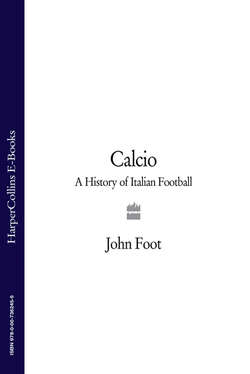Читать книгу Calcio: A History of Italian Football - John Foot - Страница 80
Sweepers Old and New. The Great Inter and beyond
ОглавлениеWhen football histories are written, one team is closely associated with the successful application of catenaccio: Helenio Herrera’s all conquering Great Inter side of the 1960s. Herrera, characteristically, claimed to have devised catenaccio, calling it ‘a tactical system which I invented’, but he also tried unsuccessfully to change its name, calling his method ‘the cement’. Herrera’s version of events – like that of Viani – should be treated with caution. It is often said that it was club president Angelo Moratti who convinced Herrera to adopt more defensive tactics, and Brera argues that Herrera was ‘converted’ to catenaccio in desperation after a poor start by Inter in the early 1960s.8 There is no doubt that the exuberant Argentinian manager introduced important modifications to the simple ‘extra defender’ system, adapting catenaccio to the players he brought into the team.
The Inter defender who revolutionized football was a statuesque, blond ‘giant’ called Giacinto Facchetti. After coming through Inter’s youth team, Facchetti played one of his first games for Inter in extraordinary circumstances. In protest against a league decision Herrera sent out a team of youngsters to play the mighty Juventus.9 They lost 9–1 (a record) with Omar Sivori scoring six (another record). Facchetti became an Inter regular in 1962 and was a fixture in the team for eighteen years, as well as playing 94 times for Italy. Herrera moved Facchetti from centre-back to left-back, and gave him a licence to attack, thirty years before the advent of overlapping full-backs in the 1990s. Facchetti’s gallops down the wing turned defence into attack and his physique and technical ability made him perfectly suited to his new role of a ‘fluid’ full-back. He soon became one of the first ‘total footballers’ – able to defend, stride forward and score goals. Facchetti was good enough up front to score ten times in a Serie A season, a better haul than most forwards. Born in the local Lombard town of Treviglio, Facchetti was idolized by Gianni Brera amongst others, being compared to a mythical god. Inter through-and-through, Facchetti remained within the club after retirement, becoming club president in 2004. The ‘Good Giant’ died on 4 September 2006 after a brief and terrible illness. Huge crowds turned out for his funeral, testimony to the affection with which Facchetti was held by fans of every team.
Were Inter a defensive side? The bare figures of Herrera’s Inter teams tell something of the story. Herrera’s more attacking teams failed to win the scudetto in his first two seasons in charge. In his third season – 1962–3 – the defence was watertight, and Inter took the championship in a low-scoring season. Inter soon developed into a team with a superb back five, an excellent goalkeeper and an attack that veered from the good to the prolific. Herrera’s defensive reputation is not proven, and he almost always selected a team (usually against his will) which contained at least one player – Mario Corso – who spent much of the game strolling around, when he was not actually motionless. The worldwide unpopularity of Inter’s ‘style’ of football had its roots in their long and successful European campaigns. Inter’s will to win and cynical tactics created the legend of Herrera as the king of catenaccio, a legend Herrera was happy to play up to. Of course, tactics in themselves are neutral. Herrera’s teams could be boring, but they were often spectacular, and, above all, they were winners.
Within the Great Inter’s impregnable defensive system, the sweeper was all-important. By the 1960s, the role of the libero had changed. Early sweepers would invariably boot the ball as far away as possible, into space for attackers to run onto. Soon the sweeper became a player who could construct play, passing the ball out to the wings or straight to the ‘director’ in midfield. This role for Inter was filled, until 1967, by Armando Picchi, a Livornese-born, bony-faced defender who had previously been a right-back.10
